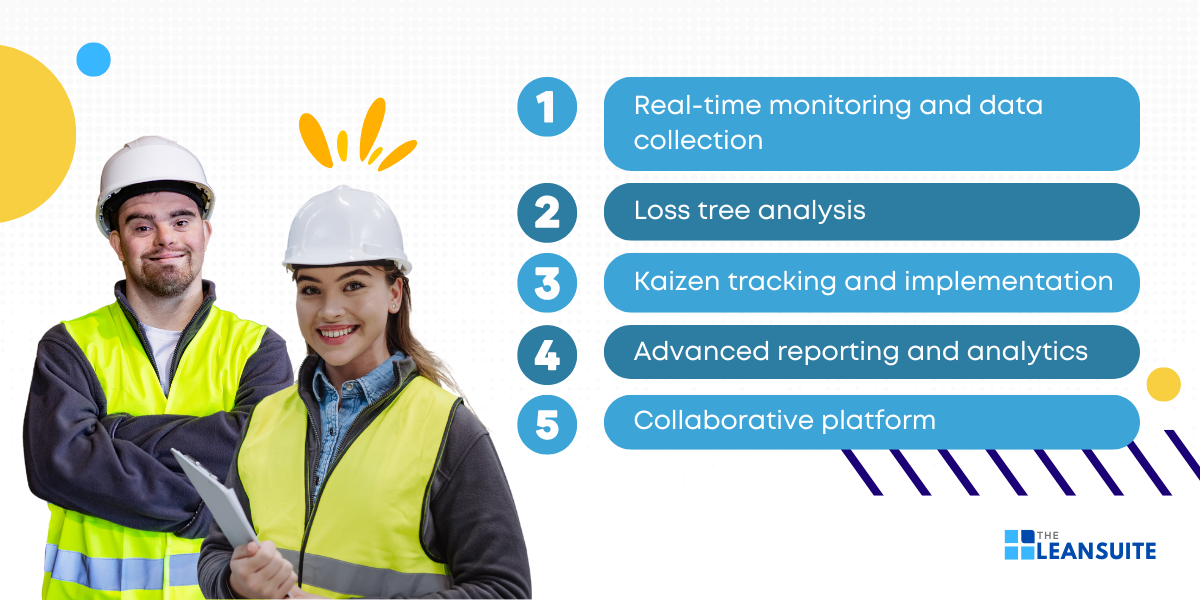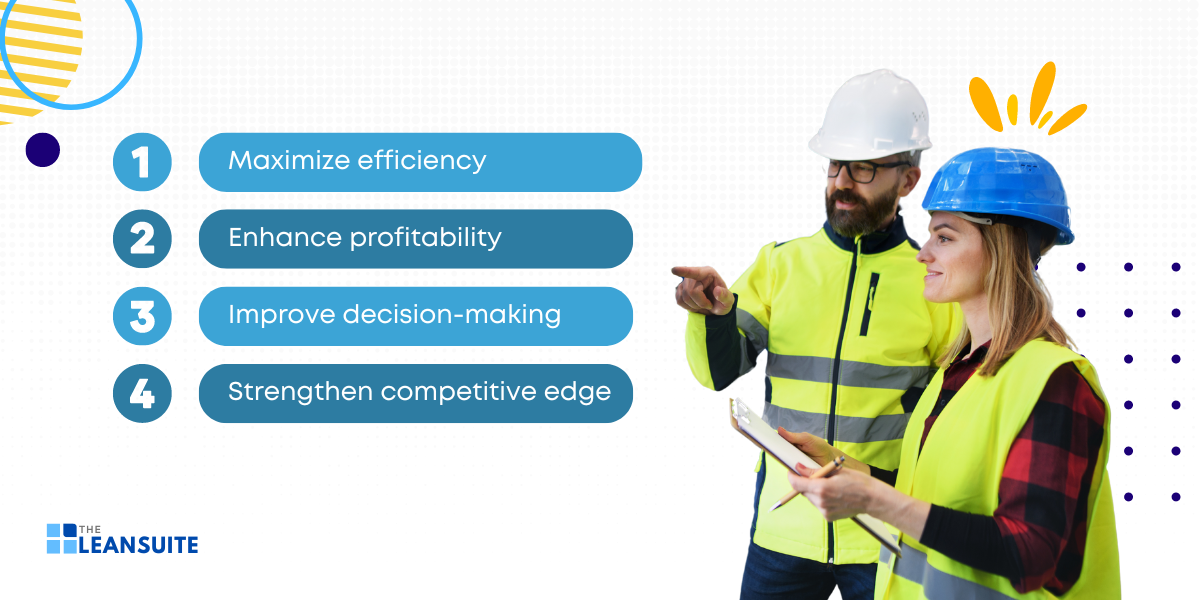Imagine a world where every penny saved contributes directly to your company’s bottom line. In the fast-paced and highly competitive world of manufacturing, identifying and mitigating losses is essential for maintaining efficiency, profitability, and a competitive edge. LeanSuite, an innovative and powerful tool, offers a comprehensive solution designed to minimize causal and resultant losses, empowering your finance teams and engineers to drive continuous improvement and cost savings. This blog post will explore how LeanSuite can transform your approach to loss management, fostering a culture of continuous improvement and sustainable growth.
Understanding causal and resultant losses
Before exploring how LeanSuite can help you minimize causal and resultant losses, it’s important to first understand the types of losses manufacturers face:
Causal (direct) losses
A causal, or direct, loss refers to the immediate and direct consequences of an adverse event, impacting your operations or assets in a tangible and quantifiable manner. In other words, these losses occur as a direct result of incidents. For example:
- Machinery breakdowns: When a machine breaks down, production halts, leading to an immediate loss in productivity
- Raw material spoilage: Raw material spoilage due to improper storage or handling directly affects inventory levels and operational efficiency
- Injuries on the shop floor: Injuries on the shop floor can lead to work stoppages and medical expenses
Due to their straightforward nature, causal losses are typically easier to identify and measure. Thus, allowing you to quickly assess the financial impact and implement corrective actions to mitigate further damage.
Resultant (consequential) losses
A resultant, or consequential, loss refers to the secondary effects that arise from an initial causal loss. In essence, these losses extend beyond the immediate damage and can have far-reaching impacts on a business or individual.
For instance, if your factory experiences a fire, the initial loss might include the damaged equipment and facility. However, the resultant losses could include production downtime, delayed deliveries to your clients, loss of future business opportunities, and damage to your company’s reputation.
These consequential losses often create a ripple effect, making them more challenging to quantify and manage. In short, the indirect nature of resultant losses means they can be underestimated or overlooked. However, their impact can be substantial and long-lasting.
How LeanSuite can help you minimize causal and resultant losses in your manufacturing operations
LeanSuite’s Lean Enablement Software is designed to provide a comprehensive solution to help you monitor, manage, and minimize causal and resultant losses in your manufacturing processes. Here’s how it works:

1. Real-time monitoring and data collection
Sensor integration
LeanSuite’s product seamlessly integrates with an array of sensors and IoT devices to provide real-time monitoring of your machinery and production lines. By leveraging advanced connectivity and data analytics, LeanSuite ensures that you receive instant insights into operational efficiency, potential issues, and overall performance. This integration allows for proactive maintenance, reduces downtime, and optimizes productivity. Ultimately, leading to a smarter, more efficient manufacturing process.
Data aggregation
LeanSuite collects and aggregates data from multiple sources, offering a comprehensive overview of your operations. By integrating information from various departments and systems, LeanSuite ensures that all relevant data points are captured and analyzed in real time. This holistic approach allows you to identify trends, pinpoint inefficiencies, and make informed decisions that drive continuous improvement across your organization.
2. Loss tree analysis
Building loss trees
LeanSuite empowers your engineers and finance users to build comprehensive loss trees that accurately map out causal losses and their resulting impacts. By offering a visual representation of these connections, LeanSuite aids in pinpointing the precise sources of inefficiencies within a process or system. This detailed approach not only clarifies the extent of each issue, but also highlights areas that require immediate attention. Thereby, fostering more informed decision-making.
Root cause analysis
With LeanSuite’s advanced capabilities, conducting root cause analysis becomes significantly more efficient and effective. The detailed loss tree analysis serves as a foundation for identifying the underlying causes of problems. By uncovering these root causes, LeanSuite enables you to implement targeted interventions that address the core issues rather than just the symptoms. This strategic approach ensures that solutions are sustainable and lead to long-term improvements in performance and efficiency.
3. Kaizen tracking and implementation
Continuous improvement
LeanSuite’s product supports the Kaizen philosophy of continuous improvement by allowing users to create and track Kaizens—small, incremental changes aimed at improving efficiency and reducing losses. Through our intuitive platform, LeanSuite facilitates the identification of areas for improvement, encourages employee involvement, and systematically documents each step of the process. This helps you to build a culture of continuous improvement where you are continuously refining your operations and proactively problem-solving.
Savings tracking
LeanSuite equips you with the tools required to manage your savings tracking effectively. By enabling you to quantify the savings achieved through each Kaizen, LeanSuite provides clear evidence of the financial impact of your improvements. What’s more, our detailed analytics and reporting features allow you to measure cost reductions and efficiency gains. This, in turn, helps to demonstrate the tangible benefits of your continuous improvement efforts and aids in strategic decision-making.
4. Advanced reporting and analytics
Customizable dashboards
LeanSuite empowers your finance teams and engineers to create highly customizable dashboards. In other words, we enable them to track key performance indicators (KPIs) related to losses and savings with precision. These dashboards can be tailored to display real-time data, trends, and insights that are most relevant to your organization’s objectives. Therefore, fostering informed decision-making and strategic planning.
Predictive analytics
By leveraging advanced algorithms, LeanSuite offers robust predictive analytics capabilities. Basically, this feature allows you to anticipate potential causal losses before they occur, enabling proactive maintenance and risk mitigation. By identifying patterns and trends that might lead to future issues, you can take preventative measures to minimize downtime, optimize resources, and ensure continuous operational efficiency.
5. Collaborative platform
Cross-functional collaboration
LeanSuite significantly enhances cross-functional collaboration by providing a unified platform where finance teams, engineers, and other stakeholders can seamlessly work together. This integration ensures that all team members are aligned in their objectives, which is crucial for effectively reducing losses and improving operational efficiency. By fostering a culture of shared goals and transparent communication, LeanSuite helps you bridge gaps between your different departments. As a result, this leads to more cohesive and productive efforts.
Centralized data access
With LeanSuite, all relevant data and analyses are accessible from a centralized platform. As a result, this effectively breaks down information silos within your organization. That is to say, this centralized data access not only enhances communication among team members, but also facilitates more informed decision-making. By ensuring that everyone has access to the same up-to-date information, LeanSuite promotes a more collaborative and efficient work environment. Thus, enabling your teams to quickly address issues and capitalize on opportunities.
The benefits of using LeanSuite

1. Maximize efficiency
LeanSuite excels in maximizing operational efficiency by carefully identifying and addressing both direct and indirect losses within your manufacturing processes. Direct losses could include production delays, equipment malfunctions, or material waste. On the other hand, indirect losses might stem from inefficient workflows or unoptimized labor use.
Our software offers comprehensive tools for streamlining these operations, significantly reducing waste. By facilitating a seamless and more productive environment, LeanSuite ensures that every aspect of your manufacturing process operates at peak efficiency. Thereby, enhancing your overall organizational performance.
2. Enhance profitability
One of the standout features of LeanSuite is its ability to enhance profitability through careful tracking of savings generated from Kaizen events and continuous improvement initiatives.
Kaizen, the practice of continuous improvement, focuses on small, incremental changes that collectively result in significant improvements over time. LeanSuite helps you document and analyze these improvements, translating them into tangible financial benefits.
By providing clear visibility into where savings are occurring and how they impact your bottom line, LeanSuite empowers you to capitalize on these efficiencies. Ultimately, leading to increased profitability.
3. Improve decision-making
LeanSuite provides real-time data collection and advanced analytics, which are key in improving decision-making processes. This feature equips your teams with actionable insights, allowing them to make informed decisions quickly and confidently.
Whether it’s adjusting production schedules, reallocating resources, or identifying potential bottlenecks before they become issues, LeanSuite’s real-time data and analytics facilitate a proactive approach to managing your operations. In fact, this ensures that decisions are backed by accurate and timely information. Consequently, reducing the risk of errors and enhancing overall operational effectiveness.
4. Strengthen competitive edge
By proactively managing losses and continually improving processes, LeanSuite helps you strengthen your competitive edge in the market.
Efficient and effective operations translate to consistent quality and reliability, which are critical factors in customer satisfaction and loyalty. LeanSuite’s solutions enable you to stay ahead of industry standards, ensuring that your products meet or exceed customer expectations. This consistent quality and reliability not only enhances your brand reputation, but also positions your business as a leader in the market.
By leveraging LeanSuite, you can deliver better products faster and more cost-effectively than competitors, strengthening your position in a competitive market.
Conclusion
To sustain success in today’s manufacturing industry, it’s important to understand, manage, and minimize causal and resultant losses. LeanSuite offers a powerful solution that not only monitors these losses, but also drives continuous improvement through detailed analysis and collaborative efforts.
By equipping your finance teams and engineers with the tools they need to pinpoint inefficiencies, implement effective Kaizens, and achieve significant cost savings, LeanSuite empowers your organization to maximize productivity and profitability. Embrace LeanSuite to transform your manufacturing operations into a model of efficiency and excellence.





